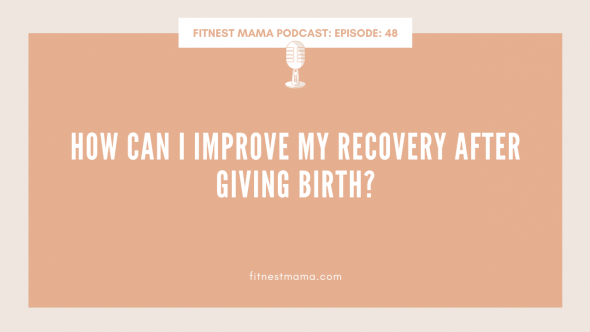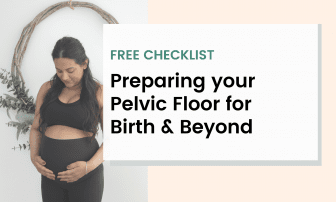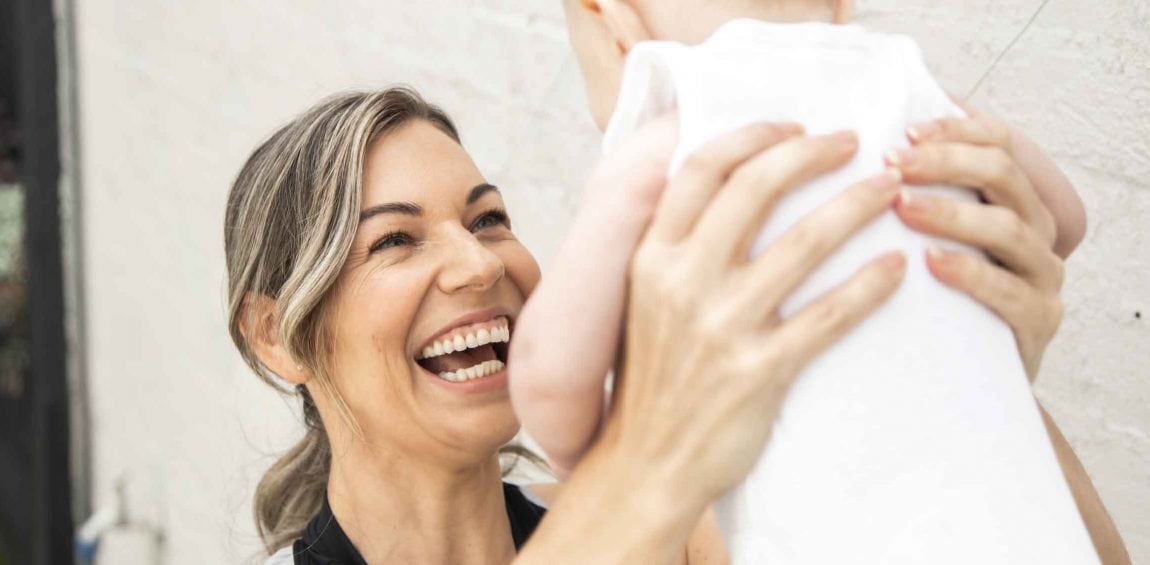Afterbirth recovery. It’s something that as a new mom, it is so easy to fall by the wayside. I totally get it. It’s quite funny, isn’t it? We spend nine months growing a baby nine months during pregnancy, and then suddenly this little newborn is upon us. And those first few weeks, there’s the gorgeous newborn smell the newborn cry, all the newborn feeds, and everything else that life with a newborn brings. So learning how to breastfeed, change nappies navigate life navigate your other children in the house school drop-offs. All in a sleep-deprived haze can often leave us forgetting about our own personal recovery.
So that’s what this episode is about. It’s about those first few weeks after birth. And I really do feel these are crucial few weeks to setting up ourselves and setting up our recovery. And laying the foundations for a beautiful recovery that we deserve as mums. We’ve spent nine months cooking a baby. We give out all once the baby comes out. So to be able to invest in our bodies and help to give back to our bodies after having a baby I think is so important. And it’s one that often gets put to the bottom of the to do list.
I get it, there’s so many other demands, important roles that we have to fulfil and that we need to do that our recovery often takes backseat. So that’s what this episode is all about is how to help boost your afterbirth recovery in those first vital few weeks after birth, when perhaps you’re not actually paying attention to yourself because of everything else. So hopefully you’re listening to this either when you’re in those first few weeks, or when you’re pregnant, which is even better. If you’re listening to this when you’re pregnant, hopefully, you can set it in motion so that when you’re in the thick of it, you’re not forgetting about it.
So here we go. During pregnancy and childbirth, everything has stretched. So it’s not just your muscles that have stretched, not just your abdominal muscles and your pelvic floor that stretched, it’s all the fascia and the connective tissue, normal important soft tissue structures in the body. And this is why it doesn’t matter if you’re the strongest woman in the world. If you’ve had a baby, everything still stretched. And often it is time that is required for all those structures to knit together. So if we think about that elastic band that gets stretched, we want that natural recoil to occur as much as possible. And this isn’t where it’s a matter of doing more strength work or more exercises to get you stronger. Because in this situation, I do really feel when all those soft tissue structures, so you know, when you’re eating a piece of steak, it’s not just the muscle that you eat the red meat, it’s there’s the white fascia, that white connective tissue in the stake too. I’m sorry if you’re vegetarian, or you hate steak, but hopefully you know what I mean when I’m talking about that fresh up, and often it is time that we need for that fascia and the connective tissue to knit together and heal.
So here are just a few simple ways to help boost your afterbirth recovery. So that elastic recoil can occur as much as possible because this will lay the foundations for your postnatal rehab for your postnatal recovery, whether or not you’re wanting to run around with the kids at the park without worrying about leaking, or whether or not you’re wanting to run the next marathon. These are all important things to consider.
Okay, so the first, number one, it’s still a long roll to get out of bed. And this is one if you’re pregnant, it’d be amazing to start practicing this now. So practice getting out of bed like an old person. So rather than doing a sit up to get out of bed and coming straight from lying on your back into sitting, we just want to break that down. So first of all, try rolling on to your side, and then use your arms to push it up into sitting as your legs fall over the bed. And hopefully that makes sense. If it doesn’t come and find me on Instagram @fitnestmama, because I’ve demonstrated this in a few posts along the way. So scroll back through my earlier posts. So number one log roll to get out of bed, this will really help you that abdominal recovery, whether or not you’ve had a vaginal birth or a caesarean birth.
Number two, is having bursts of horizontal rest throughout the day. I don’t mean lying down all day every day, which is virtually impossible. But snatching five minutes here or 10 minutes there, if you can have a lie down. That’s amazing. So this is where it can be really helpful to breastfeed lying down if you can master that skill. And I know lying down, breastfeeding can be a lot more challenging. And personally, I didn’t master this until my third baby. But it was a godsend when I did finally master it. So breastfeeding lying down. Or if you’ve got a toddler, old children, instead of reading them a book and sitting have a lie down with them to read. And even just when if you’re on the phone five minutes, so it doesn’t need to be a long period of time, but the bursts of horizontal rest. So not sitting with your legs up actually lying down. Because this helps to take gravity off all those structures that have been stretched. And your pelvic floor has also been stretched. If you’ve had a caesarean birth too, you still have nine months of rolling babysitting upon all those muscles down the bottom.
Okay, so log roll to get out of bed, bursts of horizontal rest. And the next one is building up walking gradually. I often find moms come and tell me that, you know they’re feeling really good. And they decided to go for a half hour walk, which might not seem much to you, if you’re used to walking a lot. But if you’ve just given birth, I really would recommend gradually building up to 30 minutes. So don’t suddenly just leave the house for your first 30-minute walk if you haven’t really left the house much at all. So I do have a general rule of thumb that is for week one to walk around five minutes. So around your house around your home around the hospital ward, that sort of thing. Week 2, 10 minute bursts. And you might do that a few times a day. Week 3, 15 minutes, week 4, 20 minutes, week 5, 25 minutes. And then by the time you get to week 6, you’re doing 30 minutes, like I’m sure you can all go and walk 30 minutes. But what I’m thinking about when I’m giving this guideline is how much weight and the effect of gravity that’s having on your pelvic floor and core structures. So again, if we think about that elastic band that has been stretched, it’s a bit saggy than usual perhaps. And if we are then up against gravity and putting, you know, walking and staying up against gravity and putting that load through that elastic band, it’s going to stay in that stretched position. And we want that natural recoil to occur as possible. And that’s why I do really believe that building up gradually is key. And of course this will change. Also, it’s not one size fits all, some of you might have had a more complicated delivery, and walking 30 minutes by six weeks might actually be too much for you. Whereas for others, it’ll be easy to take off. So I find it hard to give these general recommendations because it is so individualized depending on you and your body and your birth experience. So as always, this is general information only. And if you’ve got any questions or concerns do go and consult your health care provider.
Okay, so the other next tip, which is can be really challenging, especially if you’ve got a toddler in the house. It’s to avoid lifting anything heavier than your newborn for six weeks. We’re often told this if you’ve had a caesarean birth, you’ve probably been told this to try to avoid lifting anything heavier than your baby. But I also recommend if you’ve also had a vaginal birth, we’re just wanting to let everything recover. And I do feel the more we do. The more we’re lifting the more we’re up against gravity. It’s just harder for that natural recoil to occur and that recovery to take place. Avoiding lifting your toddler I know it’s super challenging. This won’t be possible all the time. I get it. Sometimes when you do just need to lift your toddler but if you can brainstorm as much as possible. For example, having your cuddle couch I’m sure I’ve talked about it on earlier episodes or getting set of steps to move around the house. It’s a brainstorming as much as possible, when do you usually need to lift your toddler? And how do you avoid that and getting into that habit when you’re pregnant too, so it’s not a big shock to your toddler.
And the other thing with not lifting anything heavier than your newborn is that then hopefully you’re not lifting your pram in and out of the car, and the capsule is a huge one, the capsule can weigh so much with a baby inside. So brainstorming with your partner or whoever’s in home that can help you. I think that’s brilliant. And the other thing is, if you’re trying to limit your driving as much as possible, that means that you’re probably spending less time on your feet or in sitting, and you’re able to put your feet up more have more bursts of horizontal rest. And it’s a bit of a cycle. So obviously, you got to do what’s right for you and yourself and your mental health. And what you need to do is great. But the first one was lob roll to get out of bed. The second one was bursts of horizontal rest, build up your walking, gradually, avoiding heavy lifting, and that includes the laundry, and vacuum cleaners, so perfect time to outsource that.
Although last but not least, is definitely get started with some pelvic floor, and your postnatal rehab. And this is a big topic, and there’s lots of episodes on this. But I believe every woman out there does deserve to invest in themselves, and does it deserve to help their body recover. You’ve just produced a beautiful baby. And now it’s time to give back to your body. So once this early postnatal rehab period has finished and you’ve got your medical clearance, you’re able to get back into a little bit more gradually. This is when being aware of what is your postnatal rehab going to consist of. And hopefully it’s more than just walking with a plan. And walking is fantastic. And it’s a great form of exercise. But I really do feel we need to help our pelvic floor recover, we need to help our abdominals recover, our core, our whole body strength and have a bit of an action plan so that you can have that whole body sort of concerted effort to help your body strengthen again after childbirth will really help to set yourself up for future pregnancies, but also beyond to menopause and everything that comes after menopause.
So there you have it, ladies, short and sweet. And hopefully that just got you thinking about ways that you can apply what I’ve talked about in your life and see how it can work for you. Now have a great day everyone and I look forward to you joining me next week for another episode of the FitNest Mama Podcast.
Thanks for listening to the FitNest Mama Podcast brought to you by the FitNest Mama Freebies found at www.fitnestmama.com/free. So please take a few seconds to leave a review, subscribe, so you don’t miss an episode. And be sure to take a screenshot of this podcast, upload it to your social media and tag me, @fitnestmama, so I can give you a shout out too. Until next time! Remember, an active pregnancy, confident childbirth, and strong postnatal recovery is something that you deserve. Remember, our disclaimer, materials and contents in this podcast are intended as general information only and shouldn’t substitute any medical advice, diagnosis or treatment. I’ll see you soon!





